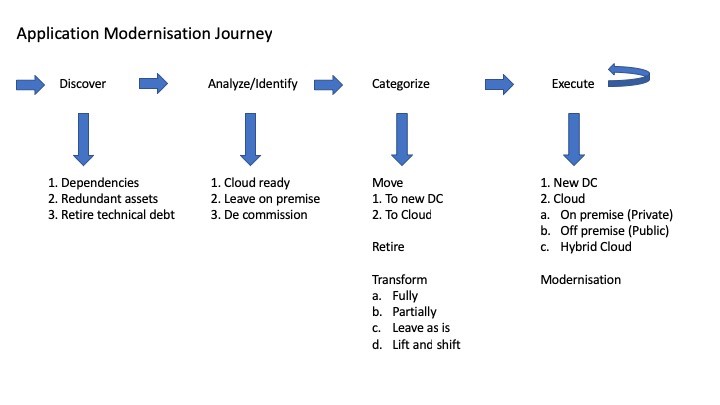About cookies on this site Our websites require some cookies to function properly (required). In addition, other cookies may be used with your consent to analyze site usage, improve the user experience and for advertising. For more information, please review your options. By visiting our website, you agree to our processing of information as described in IBM’sprivacy statement. To provide a smooth navigation, your cookie preferences will be shared across the IBM web domains listed here.
Cloud
Application Modernisation – Rewrite what’s necessary, but don’t necessarily rewrite!
3 December, 2018 | Written by: David Metcalfe
Categorized: Cloud
Share this post:
I’m in a very fortunate position to speak to lots of customers from various industries, across the UK, lately the conversations have been about application modernisation and the choices available to businesses. In this first in a series of blogs I want to share the options that IBM brings to organisations who are embarking on an application modernisation/business transformation journey.
Business pressures demand faster time to market and to application modernisation. Your existing estate determines the best approach to modernisation. Containers, Kubernetes, virtualisation and microservices are proven to deliver speed and simplicity, and are being adopted rapidly.
The initial forays for most enterprises are focused on the easy things. Moving basic applications to cloud infrastructure to cut costs, and building new applications on the cloud to speed innovation.
But to date, only about 10 to 20 percent of applications (let’s call this the easy stuff and is primarily a lift and shift) have moved to the cloud. The next 80 percent of the cloud opportunity (the hard stuff) focuses on shifting business applications to the cloud and optimizing everything from supply chains to sales transactions and this is where the hybrid approach is vital for businesses
Consequently many organisations are being advised to abandon their legacy applications and re-write as cloud native applications. There are other choices that need to be considered, before going down this particular route.
First of all this is not just a technology conversation, what about the investment in people and process that is associated with these legacy applications?
Secondly there sometimes exists a perception that a “2 world” environment should exist namely the old world (legacy) and the new world (cloud/cloud native). There is no need for this separation – a single environment should be the way forward as legacy and new are intrinsically linked especially in a hybrid world.
Gartner predicts that every dollar invested in digital business innovation through to the end of 2020, will require enterprises to spend at least 3x that to continuously modernize their legacy application portfolio. Spending that money effectively, will require business leaders to carefully select the right modernisation approach for their particular application.
Gartner goes on to say that 70% of private cloud adoption is being driven by modernisation and transformation, the factors behind this are bandwidth (latency) sensitivity of data, regulatory compliance requirements, security and performance.
So what is the IBM approach? By taking a step by step approach we can identify which applications can be kept, which you can migrate (to the cloud of your choice or remain on premise) and those that may need rewriting. This way we ensure you leverage the investments already made in skills, knowledge and technology, whilst benefiting from cloud in a quick and timely manner.

The journey starts with an inventory/discovery of your existing applications. From there, as the diagram shows, there are many paths to follow. IBM’s skills and experience in middleware provide unique insights and approaches to modernise your existing estate with speed, confidence, and reduced risk.
Read how Illmarinen modernised their applications with IBM Cloud Private https://www.ibm.com/case-studies/ilmarinen-icp and for more information visit https://www.ibm.com/cloud/application-modernization/
Coming up in blog 2, I will focus on IBM Transformation Advisor which is part of the IBM Cloud private (ICp) solution, and how it can rapidly help you along the application modernisation journey.

David Metcalfe
Red Hat Synergy Team (AM&I Cloud Paks)
More Cloud stories
By Col Chambers and Ed Gillett on 5 February, 2025
Preparing for the defence of the Realm
In light of current conflicts, the UK is now faced with real-world military decisions that will affect our immediate future. Ed Gillett and Col Chambers assert that industry and government must switch to a readiness mindset before the European post-war peace shatters. “My vision for the British Army is to field fifth-generation land […]
By Juan Bernabe Moreno and others on 12 December, 2024
Frontier Fusion: Accelerating the Path to Net Zero with Next Generation Innovation
Delivering the world’s first fusion powerplants has long been referred to as a grand challenge – requiring international collaboration across a broad range of technical disciplines at the forefront of science and engineering. To recreate a star here on Earth requires a complex piece of engineering called a “tokamak” essentially, a “magnetic bottle”. Our […]
By Nick Levy on 9 December, 2024
Safer Technology Change in the Financial Services Industry
Many thanks to Benita Kailey for their review feedback and contributions to this blog. Safe change is critical in keeping the trust of customers, protecting a bank’s brand, and maintaining compliance with regulatory requirements. The pace of change is never going to be this slow again. The pace of technology innovation, business […]





























